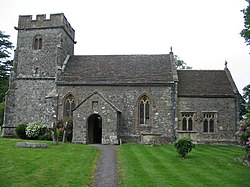Penselwood
| Penselwood | |
| Somerset | |
|---|---|
 St Michael's Church, Penselwood | |
| Location | |
| Grid reference: | ST755315 |
| Location: | 51°4’56"N, 2°21’4"W |
| Data | |
| Population: | 273 (2011[1]) |
| Post town: | Wincanton |
| Postcode: | BA9 |
| Local Government | |
| Council: | South Somerset |
Penselwood is a village and parish in eastern Somerset adjacent to the borders with Dorset and Wiltshire. It is located four miles north-east of Wincanton, four miles south-east of Bruton, four miles west of Mere, and file miles north-west of Gillingham. The south-east of the parish borders Zeals and Stourhead in Wiltshire, and Bourton in Dorset. The parish of Penselwood forms part of the Norton Ferris Hundred.[2]
It is the start of the Leland trail a 28-mile footpath which runs from King Alfred's Tower to Ham Hill Country Park.[3]
Name
The mediæval form of the name was "Penn in Selwood", where pen (Brittonic for "head") probably referred to a hill and Selwood was the Selwood Forest which once surrounded the area.[4] Ford associated nearby Ilchester with the Cair Pensa vel Coyt [5] listed among the 28 cities of Britain by the History of the Britons on the basis that it should be read as an Old Welsh form of 'Penselwood'[6] (coit being Welsh for "forest"), although others view it as three separate words: Pensa or Coyt. Bishop Ussher believed the listing referred to Exeter instead.[7]
History
A couple of miles north of the village amidst the trees is the remains Kenwalch's Castle, an Iron Age hill fort which may be the location of the Battle of Peonnum in 658,[4][8] mentioned in the Anglo-Saxon Chronicle. The English also made a stand here against the Viking invader Cnut the Great in 1016.
Pen Pits quern quarries north of Combe Bottom are a series of bowl shaped pits which were used as stone quarries during the Iron Age, Romano-British and Middle Ages.[9]
Just outside the village is the site of the mediæval motte-and-bailey castle known as Ballands Castle.[10]
Geography
Moldrums Ground includes a dry woodland surrounding unimproved grassland. Ponds on the site provide a habitat for northern crested newt.[11] It is a local nature reserve.[12]
Media
Penselwood is the setting for James Long's books, Ferney and its sequel, "The Lives She Left Behind", both of which mention many of the historical events that took place in or near the village.
References
- ↑ "Statistics for Wards, LSOAs and Parishes — SUMMARY Profiles" (Excel). Somerset Intelligence. http://www.somersetintelligence.org.uk/files/Somerset%20Census%20Key%20Statistics%20-%20Summary%20Profiles.xls. Retrieved 4 January 2014.
- ↑ "Somerset Hundreds". GENUKI. http://www.genuki.org.uk/big/eng/SOM/Miscellaneous/. Retrieved 18 October 2011.
- ↑ "The Leland Trail". Discover South Somerset. http://www.visitsouthsomerset.com/index.jsp?articleid=12642. Retrieved 30 November 2009.
- ↑ 4.0 4.1 Bush, Robin (1994). Somerset: The complete guide. Wimborne: The Dovecote Press Ltd. pp. 167. ISBN 1-874336-26-1.
- ↑ Nennius (attrib.). Theodor Mommsen (ed.). Historia Brittonum, VI. Composed after AD 830. Hosted at Latin Wikisource.
- ↑ Ford, David Nash. "The 28 Cities of Britain" at Britannia. 2000.
- ↑ Newman, John Henry & al. Lives of the English Saints: St. German, Bishop of Auxerre, Ch. X: "Britain in 429, A. D.", p. 92. James Toovey (London), 1844.
- ↑ Havinden, Michael. The Somerset Landscape. The making of the English landscape. London: Hodder and Stoughton. p. 79. ISBN 0-340-20116-9.
- ↑ "Pen Pits". English Heritage. http://www.pastscape.org.uk/hob.aspx?hob_id=202568. Retrieved 21 September 2014.
- ↑ Adkins, Lesley and Roy (1992). A Field Guide to Somerset Archaeology. Wimborne, Dorset: Dovecote Press. ISBN 0-946159-94-7.
- ↑ "Moldram's Ground". Pen Selwood. http://penselwood.ning.com/page/moldrams-ground. Retrieved 25 August 2015.
- ↑ "Moldrums Ground". Natural England. http://www.lnr.naturalengland.org.uk/Special/lnr/lnr_details.asp?C=35&N=&ID=1391. Retrieved 26 August 2015.
Outside links
| ("Wikimedia Commons" has material about Penselwood) |